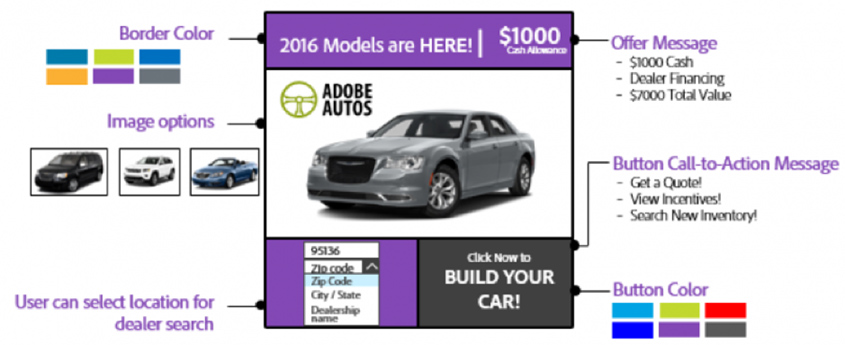6 min to read
Why Programmatic Advertising?
Display advertising campaigns have changed a lot since they first launched. Today, target publishers and placements alone are not enough- you need to incorporate segmentation that will help to increase campaign affinity with your target audience and adjust the ads to fit the user’s interests.
Programmatic Advertising: The Future of Display
Display campaigns usually bring to mind low CTRs, huge budgets needed to create reach and generate volume, and only being useful for brand awareness. Due to the nature and setup of those outdated display campaigns, it was true. But, today, we can maximize the efficiency of our campaigns, using lower budgets to expect high affinity with users.
What has changed in the last years in this type of campaigns and ad buying?
The answer is data. Data is an ally to help the media industry create more accurate display campaigns. Every online click, swipe, scroll or “like” we do, we generate data (when browsing, checking e-mail, GPS apps, locations apps, mobile, IOT, wearables devices, Androidauto, etc.). On the other side, now we have more powerful and accessible DMPs to allow us to save and create more value from that data and leverage it with programmatic advertising.
Here are 5 ways that you can drive stronger results with programmatic advertising (and why you should leave traditional display campaigns in the past).
1. Forget placements and publishers: target real users!
In previous years, our ad buying strategies relied on publishers. And, for a single campaign, several publishers. But now, with programmatic advertising campaigns, we can target and segment users despite the publisher users are browsing. Every user leaves behind a trail of behavioral data such as locations, type of websites, sections and contents we browser. That data is gathered by DMPs (Data Management Platforms) allowing us to have clusters of users that have affinity with a certain topic, football for example. These users are consuming and browsing in websites related with football. We can then match that data with our web analytics data and build custom segments, allowing us to target people who love football and cars. Maybe we can target those users with a campaign to sell car insurance with a sports car in a football stadium. This generates new levels of affinity between consumers and ad campaigns.

2. Match user interests with your performance data.
When your programmatic display campaign starts, you can create segments of new users that interacted with your campaign or have been exposed to a banner. With this and, with this, you’re creating more specific clusters users (for instance: users that clicked in your ad) and with real-time data. Expand these users through look-a-like models to seek more audiences and new users with very similar interests and behavior. Meanwhile, create a funnel of metrics: clusters with lower bounce rate, higher time on site, more sessions/page views, more conversions with lower CPL or even CPA. This means that you can create clusters of users according to campaign behavior and interaction, and “play” with different and optimized strategies according to consumer journey stage. Because your potential consumer is present in all sort of platforms, all you need to start is a good DMP, a good Ad Server and a very good dynamic ad template.
3. Mix your data with external data (yes, even offline data)
Mixing on and offline data strategies, you may be able to find the “perfect user” that usually overlaps between on and offline data layers. If a user is impacted by your FTA TV campaign, watches channels where your programmatic campaign is broadcasted, and also has online behavior that matches with interest segments of your display campaign, you may just find your “golden” customer. So, considering this overlap, this may be your most valuable customer. And usually, the cheapest one to convert.

But there are other layers of external and offline data that may help to improve the targeting of your programmatic advertising campaigns. If some part of your consumer journey happens offline (and this happens a lot), you may need to upload your offline data (from a CRM, for instance) and mix that data to expand audiences and seek more qualified users to your programmatic advertising display campaigns.
And, at the end of the day, what does this mean?
This means you can impact the user across screens and measure the user alongside the whole consumer journey, even if the consumer converts offline. But, if you have other reliable sources of offline data, such as market data or external data from customers, you can use it to target your programmatic campaigns and stop wasting money with the wrong users.
How and why?
By comparing the performance of your campaigns, segmenting users, and using (or excluding) different creativities. But, in most generic situations you should use this seed data to build larger users clusters with similar behaviors and interests to onboard more potential clients in advertisers consumer journey. Why? It’s simple- those users have a much higher probability to love your products and being positively impacted by your ads, leading them to convert with a lower CPL and CPA.
This means that you will generate more results with less paid media budget.
4.Use your own data across multiple publishers and networks
Instead of relying on external and segmented data from each individual publisher or network, you should start to build your own DMP. This decision will help you to be data autonomous and your own decision mechanism. Additionally, this allows you to perform programmatic ad buying for your campaigns in an independent and cross network/publisher way that represents an elevated digital landscape.
Why programmatic ad buying?
Through programmatic ad buying, like Google Ads Display Network, you can get relevant impressions for your programmatic campaign goals that only impact users when they are in the right place. Programmatic ad buying also allows you to:
- have a cross-publisher frequency capping for your campaign (totally different have an overlapping capping per publisher);
- seek audience in all inventory instead of just a publisher;
- truly optimize your programmatic ad buying with data and volume so you can make smart marketing decisions.
5. Match users’ interest with specific ads
Nowadays, showing the “right” ad to the “right” customer is not enough. With all the available data and technologies, do you think it makes sense to talk to all consumers in the same way, with the same communication approach? Of course not. With users segmented by behavior and interests, the next logical step is to start working with DCO (Dynamic Creative Optimization), a.k.a. dynamic creative ads. These ads are created in real time and they are unique to that cluster of users according to user’s interests. What makes sense is to use data to allow deliver a custom-made ad (build in real time) and that ad matches with the interests of the user that is being exposed to your campaigns. DCO allows you to leverage much more than a traditional display banner, such as time, location, and stage in the customer journey.

DCO + Programmatic ad buying: the perfect match
Let’s assume your football loving user also loves pets, computers, and technology, and you’re impacting him with a display campaign. Why you should show to your user a generic one-size-fits-all ad when you have so much data about their interests? Makes no sense, right?
Imagine this scenario:
Your goal is to generate requests for loans. But loans are not a sexy product to sell unless you have a very good idea of where to “invest” the money. When a user has a strong sense of why he needs a loan, it’s easy to impact them in a critical area. How? With data. You already know that the user loves technology. Instead of showing a generic ad with loan and boring interest rates, try showing a high-end laptop. And, in the background, you can contextualize the products with a cute pet. Nobody asks a loan only because the interest’s rate is low. Users ask for credit to buy things they need or love. At the same time, on the screen of another user with different interests, there is a different ad. Because this user has demonstrated loves fast motorcycles, we can use copy that appeals to him directly and grabbing his attention: “This fast motorcycle can be yours today. Just ask for a loan. Real-time and online approval.” Sounds effective, right? The technology, platforms, and tools are already in place to allow you to start these highly effective, programmatic advertising campaigns.
Let’s start your new programmatic ad campaign?
In summary, if data is the fuel for your programmatic advertising campaign, you must know how to feed your programmatic ad buying strategy and paid media in order to extract the most possible profit for your brands and products. Buying bulk inventory in isolated publishers is an old school technique.
Why wasting banners impressions with the wrong users? Why speak with all users in the same way? Why not create layers of users according to performance and consumer journey?
These old mistakes (even from offline media advertising) lead many advertisers to reduce media investments in display, but that decision only increased the barrier to building branding awareness in a fragmented ecosystem. In this fragmented online space, only with DMPs are you able to build up a cluster of interests to communicate with your consumers again in an impactful way. Through programmatic ad buying, like Google Ads Display Network, you can relevant impressions for your programmatic campaign goals, only when the user is in the right placement.
Ready to get started with your programmatic advertising journey?
Codedesign is a digital marketing agency specializing in data-driven online sales and lead generation solutions for brands in a variety of verticals. Contact us to schedule a consultation with one of our digital marketing experts.
About the Expert:
 This week’s article was written by Miguel Maio. Miguel is the Chief Marketing Officer at Codedesign and has been working in SEM & PPC since 2006. Prior to joining the Codedesign team, Miguel was serving as Head of Digital at WPP/Groupm, leading strategies for some of the largest brands in Portugal such as automotive and banking. When Miguel isn’t strategizing programmatic campaigns for Codedesign’s clients, you can find him training the next generation of digital marketers at the University of Porto, or riding his GTR Kawasaki along the Portuguese coastline. Connect with Miguel.
This week’s article was written by Miguel Maio. Miguel is the Chief Marketing Officer at Codedesign and has been working in SEM & PPC since 2006. Prior to joining the Codedesign team, Miguel was serving as Head of Digital at WPP/Groupm, leading strategies for some of the largest brands in Portugal such as automotive and banking. When Miguel isn’t strategizing programmatic campaigns for Codedesign’s clients, you can find him training the next generation of digital marketers at the University of Porto, or riding his GTR Kawasaki along the Portuguese coastline. Connect with Miguel.
Add comment ×